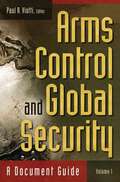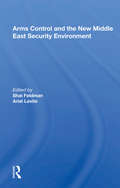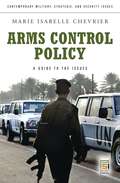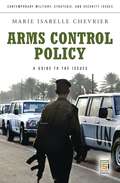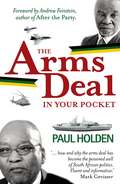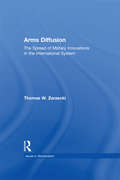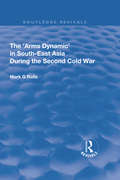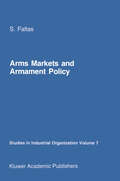- Table View
- List View
Arms Control and Disarmament Law (Elements of International Law)
by Stuart Casey-MaslenArms control and disarmament are key elements in promoting international peace and security. In recent decades the scope of disarmament law has broadened from a traditional focus on weapons of mass destruction to encompass conventional weapons. In this new volume in the Elements series, Stuart Casey-Maslen provides a concise and objective appraisal of international arms control and disarmament law. In seven concise chapters, he traces the history of arms control and disarmament in the modern era, addressing the issues surrounding biological and chemical weapons, the Non-Proliferation of Nuclear Weapons, and conventional weapon and arms transfer regimes. He concludes by considering how, in order to remain relevant, disarmament and arms control will need to adapt to rapidly evolving technologies that defy traditional means of verification and control. Arms Control and Disarmament Law is an accessible, go-to source for practicing international lawyers, judges and arbitrators, government and military officers, scholars, teachers, and students.
Arms Control and Disarmament Law (Elements of International Law)
by Stuart Casey-MaslenArms control and disarmament are key elements in promoting international peace and security. In recent decades the scope of disarmament law has broadened from a traditional focus on weapons of mass destruction to encompass conventional weapons. In this new volume in the Elements series, Stuart Casey-Maslen provides a concise and objective appraisal of international arms control and disarmament law. In seven concise chapters, he traces the history of arms control and disarmament in the modern era, addressing the issues surrounding biological and chemical weapons, the Non-Proliferation of Nuclear Weapons, and conventional weapon and arms transfer regimes. He concludes by considering how, in order to remain relevant, disarmament and arms control will need to adapt to rapidly evolving technologies that defy traditional means of verification and control. Arms Control and Disarmament Law is an accessible, go-to source for practicing international lawyers, judges and arbitrators, government and military officers, scholars, teachers, and students.
Arms Control and Europe: New Challenges and Prospects for Strategic Stability (Contributions to International Relations)
by Polina Sinovets William AlberqueThis book examines the recent changes in strategic stability, caused by the collapse of the international security architecture. Against the background of Russia's invasion of Ukraine, international experts discuss topics and critical issues such as the revanchist strategy of Russia and the readiness of the United States (US) and Europe to give an adequate response; the influence of new technologies in the future of nuclear deterrence; and the crumbling of the arms control and nonproliferation system under the new challenges. The book explains how the combination of these factors lead to a crucial change of strategic stability and the international security landscape, the first such change since the end of the Cold War.Divided into three parts, the book presents timely analyses on (1) US, Russia: New Challenges and Strategic Stability in Europe; (2) Extended Deterrence and Arms Control in Europe; and (3) Regional Dimensions of Strategic Stability in Europe. It further offers perspectives from and case studies on different countries, such as Ukraine, France, Germany, the United Kingdom, the USA, Turkey, Poland, and Romania.This book is a must-read for scholars for international relations, as well as policy-makers interested in a better understanding of the changing international security architecture, Russia's strategy, arms control, nonproliferation, and the future of nuclear deterrence.
Arms Control and Global Security [2 volumes]: A Document Guide [2 volumes] (Praeger Security International)
by Paul R. ViottiAn essential guide offers a comprehensive collection of edited and annotated arms-control documents, dating from the late-19th century to the present day.Sometimes successful and sometimes not, arms-control agreements are strenuously negotiated by the parties involved, yet they quickly become obsolete as technology advances and new weapons come on the scene. Thus, such agreements are best understood strategically, not as ends in themselves, but rather as one essential avenue of securing national and global security—an important means of allowing countries around the world to work out their differences at the negotiating table instead of on the battlefield. Arms Control and Global Security: A Document Guide offers an unprecedented and comprehensive collection of arms-control documents dating from the late-19th century to the present. The book includes documents addressing the control of weapons of mass destruction, the banning of biological and chemical weapons, the weaponization of space, regional arms control, and bilateral agreements, as well as the limitations of conventional weaponry. The documents are edited and annotated for nonspecialists, and charts, tables, and sidebars provide additional information throughout.
Arms Control And The New Middle East Security Environment
by Shai FeldmanThis volume incorporates the talks delivered at a conference on 11 Arms Control and the New Middle East Security Environment, 11 held in Ginosar (Israel) in January 1992. The conference was organized within the framework of the Project on Security and Arms Control in the Middle East conducted by Tel Aviv University's Jaffee Center for Strategic Studies. Some 28 scholars from eight different countries, together with some 30 Israelis, took part in the conference deliberations.
Arms Control And The New Middle East Security Environment
by Shai Feldman Ariel LeviteThis volume incorporates the talks delivered at a conference on 11 Arms Control and the New Middle East Security Environment, 11 held in Ginosar (Israel) in January 1992. The conference was organized within the framework of the Project on Security and Arms Control in the Middle East conducted by Tel Aviv University's Jaffee Center for Strategic Studies. Some 28 scholars from eight different countries, together with some 30 Israelis, took part in the conference deliberations.
Arms Control and Security: The Changing Role of Conventional Arms Control in Europe
by Kevin WrightThis title was first published in 2000: The aim of this text is to explore conventional arms control in Europe. The early chapters provide a primarily historical perspective, looking at the context, foundations, main provisions and institutional structure of the main agreements. The later chapters explore the continuing and likely future roles of the OSCE and NATO in the arms control process. The final chapters examine more contemporary developments by looking at the Adapted CFE Treaty and Vienna Documents agreed at the OSCE Istanbul Summit in November 1998 and the challenges posed to existing arrangements by the changing and emergent security threats that potentially face Europe.
Arms Control and Security: The Changing Role of Conventional Arms Control in Europe
by Kevin WrightThis title was first published in 2000: The aim of this text is to explore conventional arms control in Europe. The early chapters provide a primarily historical perspective, looking at the context, foundations, main provisions and institutional structure of the main agreements. The later chapters explore the continuing and likely future roles of the OSCE and NATO in the arms control process. The final chapters examine more contemporary developments by looking at the Adapted CFE Treaty and Vienna Documents agreed at the OSCE Istanbul Summit in November 1998 and the challenges posed to existing arrangements by the changing and emergent security threats that potentially face Europe.
Arms Control At Sea (Routledge Revivals)
by J Richard HillOriginally published in 1989, this book reviews the history of maritime control measures from before the First World War and provides a critical examination of both the objectives of maritime power and the concepts of disarmament, peace zones, parity, verifiability and peaceful co-existence. It argues that the objectives or maritime power are not necessarily incompatible with international security and that strategic deterrence can contribute to improved security. Limitation measures, it is argued, can in some cases be double-edged, endangering other security fields and having a destabilizing effect. The book stresses the need for non-absolute solutions in order to achieve a reasonable level of security and makes proposals for both structural and confidence-building measures along those lines
Arms Control At Sea (Routledge Revivals)
by J Richard HillOriginally published in 1989, this book reviews the history of maritime control measures from before the First World War and provides a critical examination of both the objectives of maritime power and the concepts of disarmament, peace zones, parity, verifiability and peaceful co-existence. It argues that the objectives or maritime power are not necessarily incompatible with international security and that strategic deterrence can contribute to improved security. Limitation measures, it is argued, can in some cases be double-edged, endangering other security fields and having a destabilizing effect. The book stresses the need for non-absolute solutions in order to achieve a reasonable level of security and makes proposals for both structural and confidence-building measures along those lines
Arms Control in Space: Exploring Conditions for Preventive Arms Control (Palgrave Studies in International Relations)
by Max M. MutschlerThis book puts the widely-held view that 'arms control in space is not possible' to the test and aims to explore how, and under what conditions, arms control could become a reality. Drawing upon international regimes and IR theory, Mutschler examines the success of space weapons and anti-ballistic missiles.
Arms Control in the Middle East: Cooperative Security Dialogue, and Regional Constraints
by Emily B. LandauThis is the story of a regional process in the making: from the very concept of arms control as applied to the region, through the innovative regional forum and format for discussion that was devised for the talks, to the dynamics of the talks and the question of Egypt's position within this novel regional setting. The result was that what seemed at the outset to be a most likely unpromising forum became the setting of unprecedented regional dynamics.
Arms Control Policy: A Guide to the Issues (Contemporary Military, Strategic, and Security Issues)
by Marie Isabelle ChevrierIn this work, an expert on biological weapons offers a thoughtful examination of the political and technical issues that have affected the implementation of arms control agreements from the 1960s to the present.Arms Control Policy: A Guide to the Issues examines the history of the major arms control treaties since the early 1960s. It offers readers a broad understanding of the ways in which arms control agreements were negotiated and implemented during the Cold War, the international and national events that affected treaty negotiation and implementation, and how the arms control landscape has changed in the war's aftermath. Specifically, the handbook overviews the obligations contained in bilateral U.S.-Soviet/Russian and multilateral arms control agreements covering nuclear and nonnuclear weapons. It also treats such agreements as the Biological Weapons Convention, the Chemical Weapons Convention, the Treaty to Ban Land Mines, and the Treaty to Ban Cluster Munitions. The book concludes with a look at the current challenges in the implementation of arms control agreements and the future of arms control.
Arms Control Policy: A Guide to the Issues (Contemporary Military, Strategic, and Security Issues)
by Marie Isabelle ChevrierIn this work, an expert on biological weapons offers a thoughtful examination of the political and technical issues that have affected the implementation of arms control agreements from the 1960s to the present.Arms Control Policy: A Guide to the Issues examines the history of the major arms control treaties since the early 1960s. It offers readers a broad understanding of the ways in which arms control agreements were negotiated and implemented during the Cold War, the international and national events that affected treaty negotiation and implementation, and how the arms control landscape has changed in the war's aftermath. Specifically, the handbook overviews the obligations contained in bilateral U.S.-Soviet/Russian and multilateral arms control agreements covering nuclear and nonnuclear weapons. It also treats such agreements as the Biological Weapons Convention, the Chemical Weapons Convention, the Treaty to Ban Land Mines, and the Treaty to Ban Cluster Munitions. The book concludes with a look at the current challenges in the implementation of arms control agreements and the future of arms control.
The Arms Crisis of 1970: The Plot that Never Was
by Michael HeneyThe number one Irish Times bestsellerIn 1970, Taoiseach Jack Lynch accused two cabinet ministers, Charles Haughey and Neil Blaney, of smuggling arms to the IRA in Northern Ireland. The criminal prosecution that followed was a cause célèbre at the time. All the accused were acquitted, but it generated a political crisis that would be one of the major events of modern Irish history.In the fifty years since, myth and controversy has surrounded the trial and its aftermath. Michael Heney has unearthed astonishing new evidence, raising serious questions about Lynch and his relationship with Haughey. The Arms Crisis of 1970 is the first comprehensive investigation into the arms trial prosecution, and how the jury came to their verdict of acquittal.Reviews:'An indisputable, forensic interpretation of the events of 1970... Impressive for its methodology, and is indispensable for anyone interested in what actually happened 50 years ago' Colm Tóibín, Irish Times, Books of the Year'Persuasive... A real life whodunnit written with the pace and drama of a political thriller' Eilis O'Hanlon, Irish Independent'Heney strips away the lies associated with the great Irish scandal of 1970... A ground-breaking book' Diarmaid Ferriter'Brilliant de-bunking of the myths, heroes and villains of the Arms Crisis' Mary O'Rourke, Sunday Independent
The Arms Deal In Your Pocket
by Paul HoldenThe Arms Deal’s taint of corruption has hovered spectre-like over South African politics since 1999, when Patricia de Lille’s revelations first hit Parliament. In the foreword to The Arms Deal in Your Pocket, former ANC MP Andrew Feinstein describes the Arms Deal as ‘the moment at which the ANC and the South African government lost their moral compass’. Paul Holden’s succinct, informative and devastating handbook tells the story in the simplest way possible, providing a guide to what was bought (and why), who was involved and what was covered up. The chapters are ordered chronologically to allow the reader to follow the story as it unfolded on the ground, and each chapter includes an info box and short timeline of the key dates to remember. Paul Holden is a freelance writer, researcher and historian, and the co-author (with Hennie van Vuuren) of The Devil in the Detail: How the Arms Deal Changed Everything.
Arms Diffusion: The Spread of Military Innovations in the International System (Issues in Globalization)
by THomas W. ZarzeckiWeapons proliferation is one of the most pressing global concerns following the end of the Cold War. Despite the absence of an overarching superpower conflict, armaments and related technologies have continued to spread throughout the international system. This has been particularly true in areas like East Asia and the Middle East, where the traditional two party arms races are not readily apparent. This text addresses these concerns and shortcomings using data on fourteen specific military technological innovations that diffused throughout the international system from 1960 to 1997.
Arms Diffusion: The Spread of Military Innovations in the International System (Issues in Globalization)
by THomas W. ZarzeckiWeapons proliferation is one of the most pressing global concerns following the end of the Cold War. Despite the absence of an overarching superpower conflict, armaments and related technologies have continued to spread throughout the international system. This has been particularly true in areas like East Asia and the Middle East, where the traditional two party arms races are not readily apparent. This text addresses these concerns and shortcomings using data on fourteen specific military technological innovations that diffused throughout the international system from 1960 to 1997.
The Arms Dynamic in South-East Asia During the Second Cold War (Routledge Revivals)
by Mark. G RollsThis title was first publishd in 2002. This work uses the concept of the "arms dynamic" to identify and assess the various factors which influenced arms acquisitions of Southeast Asian states during the second Cold War period from 1979 to 1989, providing an essential basis for understanding contemporary developments. The book provides a comprehensive and systematic explanation of the reasons for arms purchases in SE Asia during the 1980s and aims to fill a gap in the literature by fully exploring arms procurement processes in the region prior to the end of the Cold War.
The Arms Dynamic in South-East Asia During the Second Cold War (Routledge Revivals)
by Mark. G RollsThis title was first publishd in 2002. This work uses the concept of the "arms dynamic" to identify and assess the various factors which influenced arms acquisitions of Southeast Asian states during the second Cold War period from 1979 to 1989, providing an essential basis for understanding contemporary developments. The book provides a comprehensive and systematic explanation of the reasons for arms purchases in SE Asia during the 1980s and aims to fill a gap in the literature by fully exploring arms procurement processes in the region prior to the end of the Cold War.
Arms for Uncertainty: Nuclear Weapons in US and Russian Security Policy
by Stephen J. CimbalaNuclear weapons are here to stay. They have survived into the twenty-first century as instruments of influence for the US, Russia, and other major military powers. But, unlike the Cold War era, future nuclear forces will be developed and deployed within a digital-driven world of enhanced conventional weapons. As such, established nuclear powers will have smaller numbers of nuclear weapons for the purpose of deterrence working in parallel with smarter conventional weapons and elite military personnel. The challenge is to agree proportional reductions in nuclear inventories or abstinence requiring an effective nonproliferation regime to contain aspiring or threshold nuclear weapons states. This is the most comprehensive view of nuclear weapons policy and strategy currently available. The author’s division of the nuclear issue into the three ages is a never seen before analytical construct. With President Obama reelected, the reduction and even elimination of nuclear weapons will now rise to the top of the agenda once more. Moreover, given the likelihood of reductions in US defense spending, the subject of the triad, which is covered in Chapter One, will no doubt be an important subject of debate, as will the issue of missile defense, covered in Chapter 10. This book provides an excellent analysis of the spread of nuclear weapons in Asia and the Middle East and the potential dangers of a North Korean or Iranian breakout, subjects that dominate current policy debates.
Arms for Uncertainty: Nuclear Weapons in US and Russian Security Policy
by Stephen J. CimbalaNuclear weapons are here to stay. They have survived into the twenty-first century as instruments of influence for the US, Russia, and other major military powers. But, unlike the Cold War era, future nuclear forces will be developed and deployed within a digital-driven world of enhanced conventional weapons. As such, established nuclear powers will have smaller numbers of nuclear weapons for the purpose of deterrence working in parallel with smarter conventional weapons and elite military personnel. The challenge is to agree proportional reductions in nuclear inventories or abstinence requiring an effective nonproliferation regime to contain aspiring or threshold nuclear weapons states. This is the most comprehensive view of nuclear weapons policy and strategy currently available. The author’s division of the nuclear issue into the three ages is a never seen before analytical construct. With President Obama reelected, the reduction and even elimination of nuclear weapons will now rise to the top of the agenda once more. Moreover, given the likelihood of reductions in US defense spending, the subject of the triad, which is covered in Chapter One, will no doubt be an important subject of debate, as will the issue of missile defense, covered in Chapter 10. This book provides an excellent analysis of the spread of nuclear weapons in Asia and the Middle East and the potential dangers of a North Korean or Iranian breakout, subjects that dominate current policy debates.
The Arms Maker of Berlin: A Novel
by Dan FespermanA ruthless arms billionaire and a disgraced history professor share a terrible secret. Nat Turnbull is dragged abruptly from his quiet academic life when his former mentor Professor Gordon Wolfe is arrested for stealing top secret archive documents dating back to the Second World War. Coerced into examining the archives for the FBI, Nat finds intriguing references both to Wolfe’s activities in an Allied intelligence office in Switzerland during the war, and to a mysterious student resistance group in Berlin known as the White Rose. Following Wolfe’s cryptic clues to Europe, soon Nat is in a desperate race to unlock the truth, before it gets him killed.


